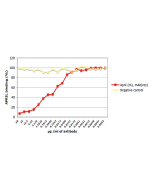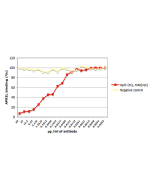Cookie Policy: This site uses cookies to improve your experience. You can find out more about our use of cookies in our Privacy Policy. By continuing to browse this site you agree to our use of cookies.
AdipoGen Life Sciences
APRIL (human) (H98) (multimeric) (rec.)

| Product Details | |
|---|---|
| Synonyms | MultimericAPRIL™; ACRP30headless:APRIL; ACRP30headless:CD256; ACRP30headless:TNFSF13; ACRP30headless:A-proliferation-inducing Ligand: |
| Product Type | Protein |
| Properties | |
| Source/Host | CHO cells |
| Sequence |
The extracellular domain of human APRIL (aa 98-233) is fused at the N-terminus to human ACRP30headless (aa 16-108) and a FLAG®-tag. |
| Crossreactivity |
Human Mouse |
| Specificity |
Binds to human and mouse BCMA and TACI. Does not bind to proteoglycans. |
| Biological Activity |
Stimulates B cell proliferation. |
| MW | ~32kDa (SDS-PAGE) |
| Purity | ≥95% (SDS-PAGE) |
| Endotoxin Content | <0.01EU/μg purified protein (LAL test; Lonza). |
| Concentration |
10µg vial: 0.1mg/ml after reconstitution. 100µg vial: 1mg/ml after reconstitution. |
| Reconstitution | Reconstitute with 100μl sterile water. |
| Formulation | Lyophilized. Contains PBS + 0.5% Trehalose. |
| Other Product Data |
UniProt link O75888: APRIL (human) FLAG is a registered trademark of Sigma-Aldrich Co. |
| Shipping and Handling | |
| Shipping | BLUE ICE |
| Short Term Storage | +4°C |
| Long Term Storage | -20°C |
| Handling Advice |
After reconstitution, prepare aliquots and store at -20°C. Avoid freeze/thaw cycles. Centrifuge lyophilized vial before opening and reconstitution. PBS containing at least 0.1% BSA should be used for further dilutions. |
| Use/Stability |
Stable for at least 6 months after receipt when stored at -20°C. Working aliquots are stable for up to 3 months when stored at -20°C. |
| Documents | |
| MSDS |
 Download PDF Download PDF |
| Product Specification Sheet | |
| Datasheet |
 Download PDF Download PDF |
APRIL is a cytokine that belongs to the TNF superfamily and binds to TACI and BCMA. It is implicated in the regulation of tumor cell growth, is involved in monocyte/macrophage-mediated immunological processes and functions as an important survival factor for plasmablasts and bone marrow plasma cells.
MultimericAPRIL™ is a high activity construct in which two trimeric APRIL ligands are artificially linked via the collagen domain of ACRP30. This construct very effectively stimulates proliferation B cell. A basic amino acid sequence (QKQKKQ) close to the N-terminus of APRIL is required for binding to negatively charged sulfated glycosaminoglycan side chains of proteoglycans. Proteoglycans mediate binding of APRIL to tumor cells as well as primary lymphoid cells.
- Human Secretory IgM Emerges from Plasma Cells Clonally Related to Gut Memory B Cells and Targets Highly Diverse Commensals: G. Magri, et al.; Immunity 47, 118 (2017)








